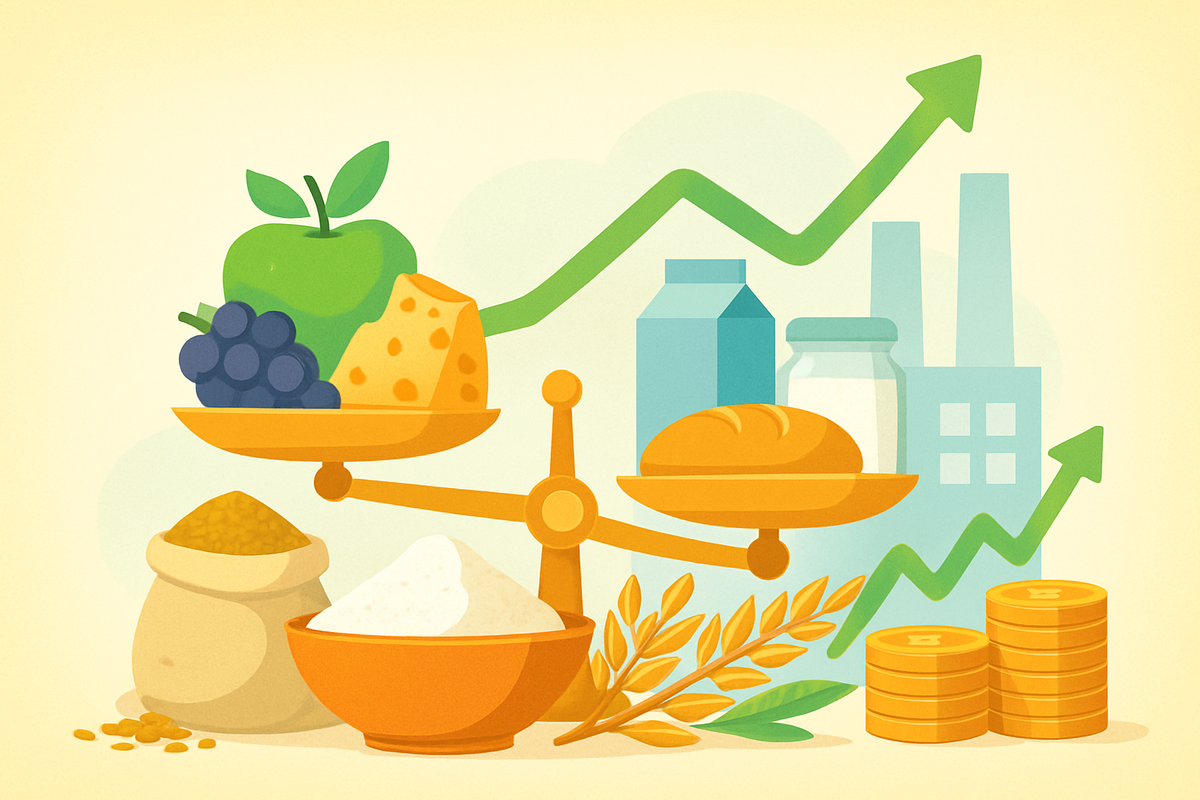
In a significant boost for the food and beverage sector, stable commodity prices are proving to be a powerful tailwind for corporate profitability, with Britannia Industries (NSE: BRITANNIA) emerging as a prime example. The Indian bakery giant recently announced a substantial 23% rise in its second-quarter profit, a performance largely attributed to a more predictable and manageable input cost environment. This trend underscores a broader positive implication for public companies heavily reliant on raw materials, as the alleviation of cost pressures translates directly into healthier profit margins and stronger financial outlooks. As global markets navigate various economic currents, the stability in commodity markets offers a much-needed respite for manufacturers, allowing them to focus on growth strategies rather than battling volatile expenses.
Britannia's Q2 Triumph: A Testament to Cost Stability
Britannia Industries (NSE: BRITANNIA) delivered an impressive financial performance for the July-September quarter of fiscal year 2026 (Q2FY26), reporting a consolidated net profit that surged by approximately 23.1% to 23.23%, reaching between ₹654 crore and ₹655.06 crore. This robust growth not only surpassed analyst expectations but also highlighted the tangible benefits of a more benign operating landscape. Revenue from operations also saw a healthy increase of 3.7% to 4.1%, totaling roughly ₹4,840 crore to ₹4,841 crore, while Profit Before Interest, Tax, Depreciation, and Amortization (PBITDA) climbed by 21.5% to ₹1,003 crore.
According to Varun Berry, Vice Chairman, Managing Director, and Chief Executive Officer of Britannia Industries, the primary drivers behind this exceptional profit growth were "relatively stable commodity prices" coupled with "sustained efforts to optimise costs across the value chain." This strategic combination allowed the company to significantly enhance its profitability by effectively managing its raw material procurement and production expenses. While the company acknowledged some transitional challenges in the latter part of the quarter due to recent Goods and Services Tax (GST) rate rationalization, these short-term hurdles are expected to normalize in the subsequent quarter, further solidifying the company's financial trajectory. Moreover, adjacent bakery categories, including Rusk, Wafers, and Croissants, continued their double-digit growth, bolstered by strong e-commerce momentum and increased in-home consumption, showcasing the company's diversified growth engines.
Who Wins and Who Loses: Navigating the Commodity Price Calm
The tranquil waters of stable commodity prices generally spell good news for the broader food and beverage industry, ushering in an era of predictable input costs and consequently, more robust profit margins. For companies where raw materials constitute a significant portion of their operational expenses, such as major food processors and consumer goods manufacturers, this stability is a game-changer. It allows for more accurate financial forecasting, optimized production, and a reduced reliance on costly hedging strategies, freeing up capital for innovation and market expansion.
Among the clearest beneficiaries are large-scale food and beverage manufacturers with diversified portfolios, like PepsiCo (NASDAQ: PEP) and General Mills (NYSE: GIS). These giants, while adept at managing volatility through sophisticated strategies, stand to gain from reduced hedging costs and the ability to fine-tune their pricing strategies with greater confidence. The stability also empowers them to invest more in product development and marketing, cementing their market leadership. Similarly, foodservice distributors such as Sysco Corporation (NYSE: SYY), which supply a vast array of food products to restaurants and institutions, can offer more consistent pricing to their clients, strengthening relationships and ensuring their own profitability.
Conversely, while overall stability is positive, some entities might find their traditional avenues for profit generation curtailed. Agricultural commodity trading houses like Archer-Daniels-Midland Company (NYSE: ADM) and Bunge Global SA (NYSE: BG), which often thrive on price arbitrage opportunities arising from market volatility, might see a reduction in such lucrative ventures. While these companies also have extensive processing operations that benefit from stable input costs, their trading arms could experience a dip in profitability from reduced market swings. Furthermore, companies with inherently inefficient operational structures or those whose business models are predicated on speculative gains from price fluctuations might struggle to fully capitalize on a stable environment, potentially lagging behind more agile and cost-efficient competitors.
Wider Implications: A Sector-Wide Shift Towards Predictability
The stability in commodity prices extends its influence far beyond individual company balance sheets, ushering in a broader transformation across the food and beverage industry. One of the most significant trends is the ability for companies to implement improved cost management and more stable pricing strategies. With predictable raw material costs, the incessant pressure to frequently adjust consumer prices or engage in "shrinkflation" lessens, allowing businesses to focus on optimizing prices for volume and market share. This newfound predictability also frees up capital and resources, enabling a greater focus on long-term industry trends such as sustainability, ethical sourcing, and product innovation, areas that consumers are increasingly prioritizing. The ongoing expansion of cold chain logistics and the dominance of e-commerce and food delivery services are also indirectly supported, as companies can better manage the costs associated with these complex operations.
The ripple effects of this stability are felt throughout the supply chain. For manufacturers, the immediate benefit is reduced pressure on profit margins, allowing them to maintain product affordability without sacrificing profitability. Retailers, in turn, experience more predictable inventory management and pricing, potentially alleviating accusations of "greedflation" that have emerged during past inflationary periods. Logistics and shipping companies also benefit from more stable energy costs, leading to more predictable transportation expenses. In the competitive landscape, this stability shifts the focus from cost reaction to competition based on product quality, innovation, and brand loyalty. Even small-scale farmers could see more consistent and predictable incomes, although other input costs like fertilizers remain a challenge.
From a regulatory and policy perspective, stable commodity prices can reduce the immediate urgency for government intervention, such as price controls or subsidies, allowing policymakers to concentrate on structural reforms like supply chain resilience and sustainable agricultural practices. However, scrutiny of corporate profits may persist, especially if consumer prices remain elevated despite falling input costs, as evidenced by past recommendations from bodies like the U.S. Federal Trade Commission (FTC) to investigate grocery sector profits. Historically, periods of high volatility, such as 2006-2008 and 2020-2022, saw significant food inflation and squeezed margins, though some large companies still posted strong profits, leading to public outcry. Conversely, periods of relative stability, like the mid-1990s, typically translated into more predictable corporate earnings, driven by volume and innovation rather than price hikes. The World Bank's projection of declining and then stable food commodity prices in 2025 and 2026 suggests a similar beneficial environment for the F&B industry, though specific commodities like coffee and cocoa might still face upward price pressures.
The Road Ahead: Opportunities and Challenges in a Stable Market
The current period of stable commodity prices opens up a multitude of short-term and long-term possibilities for the food and beverage industry, prompting strategic pivots and creating new market dynamics. In the immediate future, companies can expect improved profit margins and greater financial stability, leading to more accurate budgeting and forecasting. This allows for more competitive pricing strategies, potentially attracting price-sensitive consumers and fostering market share gains, while also reducing the immediate need for extensive and costly hedging activities. Operational streamlining can also take center stage, as businesses shift their focus from reactive cost management to proactive efficiency improvements within their supply chains and production facilities.
Looking further ahead, the long-term implications are even more profound. Stable input costs can unlock significant investment in Research & Development (R&D) and innovation, paving the way for a new wave of products, including plant-based alternatives, functional foods, and personalized nutrition options. Companies can also intensify their focus on sustainability and ethical sourcing, aligning with growing consumer demand for transparent and responsible brands. This environment also fosters brand building and premiumization efforts, as well as strategic mergers and acquisitions aimed at growth rather than defensive consolidation. Supply chain optimization can evolve beyond merely mitigating price volatility to building true resilience and efficiency.
Companies are poised to make significant strategic pivots, shifting their primary focus from mere cost management to value creation through innovation, quality, and brand differentiation. Investments in Direct-to-Consumer (DTC) channels and e-commerce are likely to accelerate, offering greater control over pricing and customer relationships. Geographic market expansion becomes less risky, and vertical integration might be pursued for quality control and traceability rather than just cost predictability. While the outlook is largely positive, challenges persist. Labor costs and shortages remain a significant hurdle, as do ever-evolving consumer preferences, intense market competition, and stringent regulatory compliance. Furthermore, non-price related supply chain disruptions, such as geopolitical tensions or extreme weather events, can still impact availability and logistics, even if base commodity prices are stable. The perception of "greedflation" could also linger if consumer prices remain high despite falling input costs. Ultimately, the industry could see innovation-led growth, intensified price competition, a widespread sustainability transformation, or a technological revolution in production, depending on how companies adapt to this more predictable, yet still complex, landscape.
Wrap-up: A New Era for Food & Beverage Profitability
The prevailing stability in commodity prices marks a pivotal moment for the food and beverage sector, shifting the industry's focus from a defensive battle against inflation to a proactive pursuit of growth and enhanced profitability. Britannia Industries' (NSE: BRITANNIA) impressive Q2 profit surge serves as a compelling testament to this trend, demonstrating how predictable input costs can directly translate into stronger financial performance and enable strategic investments. This stability is not merely a transient relief but a foundation for sustained margin expansion and a more robust industry outlook.
Moving forward, the Indian food and beverage market, valued at USD 334 billion in 2023 and projected to reach nearly USD 691.47 billion by 2030, is set for substantial expansion. This growth will be fueled by increasing disposable incomes, urbanization, evolving consumer preferences for health and convenience, and the continued proliferation of organized retail and e-commerce. The lasting impact of stable commodity prices could be a more resilient and innovative F&B industry, better equipped to meet diverse consumer demands and navigate future economic shifts. Companies with strong brands, efficient operations, and a commitment to innovation are particularly well-positioned to capitalize on this environment.
Investors in the coming months should closely monitor the sustained stability of key commodity prices, as well as consumption trends across both urban and rural markets. Scrutiny of company-specific strategies—especially those focused on innovation, distribution expansion, and cost efficiencies—will be crucial. Furthermore, an eye on government policies related to agriculture and trade, alongside M&A activity within the sector, will provide valuable insights. Ultimately, the ability of companies to translate stable input costs into improved gross and operating margins, while effectively managing other challenges like labor and evolving consumer tastes, will be a key determinant of success in this promising new era for food and beverage profitability.
This content is intended for informational purposes only and is not financial advice



